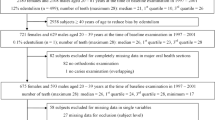Abstract.
Aim:
The aim of this study was to investigate the extent to which the anterior segment is at risk of developing disease under the influence of different types of anterior crowding and whether the degree of crowding correlates with a potential risk.
Patients and Method:
A clinical examination and cast analysis taking special account of the age and gender of 125 adult patients (63 women, 62 men) were used to determine the clinical degree of abrasion and the individual incidence of tooth infractions, tooth fractures, caries, gingivitis, periodontitis and gingival recessions (WHO-OHS method), with any correlation between the incidence of disease and the respectively calculated crowding being recorded. The diagnosis of crowding was based on the segmented arch analysis proposed by Lundström [29]. Besides evaluating the total collective, a separate evaluation was performed for the age groups 18–34 years (n = 63) and ≥ 35 years (n = 62).
Results:
No gender-related differences in crowding were determined. Patients ≥ 35 years showed significantly more crowding. An age-related increase in disease was recorded. The degree of abrasion and the individual incidence of caries did not correlate with the degree of crowding. By contrast, differences in the degree of crowding were determined in the total collective for tooth infractions (p < 0.001), tooth fractures (p = 0.004), gingival bleeding (p = 0.022), shallow periodontal pockets (p < 0.001), and gingival recessions > 3.5 mm (p < 0.001). The degree of crowding was found to correlate in the younger patients with tooth infractions (p < 0.017) and tooth fractures (p = 0.036), and in the older patients with shallow periodontal pockets (p < 0.001) and gingival recessions > 3.5 mm (p < 0.001). The incidences of disease in virtually physiologic cases of crowding (crowding ≤ 2 mm, n = 31) were compared with those recorded in extreme cases of crowding (crowding ≥ 5 mm, n = 30). All cases of crowding ≥ 5 mm were subject to gingivitis and tooth infractions, and shallow periodontal pockets occurred three times more often and gingival recession > 3.5 mm twelve times more often. The presence of deep periodontal pockets could not be attributed to the degree of crowding.
Conclusion:
With respect to the multifactorial etiology underlying the risk of disease of the dental hard tissue and the periodontal tissues, anterior crowding > 3 mm (threshold value) as an individual “host factor” represents a cumulative risk potential for chronic inflammatory processes whose consequences are manifest only at a higher age. This gives rise to a medical treatment indication within the framework of preventive treatment strategies.
Zusammenfassung.
Ziel:
Ziel der vorliegenden Arbeit war es zu prüfen, inwieweit unter dem Einfluss verschiedener Frontengstände ein Erkrankungsrisiko für die untere Frontzahnregion besteht und ob in Relation zum Ausmaß des Engstandes eine Zuordnung zu einem Risikopotenzial gegeben ist.
Patienten und Methode:
Anhand einer klinischen und modellanalytischen Untersuchung wurden unter besonderer Berücksichtigung von Alter und Geschlecht bei 125 erwachsenen Patienten (63 Frauen, 62 Männer) der Abrasionsgrad, der individuelle Befall an Zahninfraktionen und -frakturen, Karies, Gingivitis, Parodontitis und Gingivarezessionen klinisch bestimmt (WHO-OHS-Methodik) und unter Darstellung der Erkrankungshäufigkeiten der Zusammenhang mit den jeweils berechneten Engständen aufgezeigt. Die Engstandserfassung erfolgte auf der Basis der Segmentbogenanalyse nach Lundström [29]. Neben der Beurteilung des Gesamtkollektives wurden die Untersuchungsergebnisse der Altersgruppen 18–34 Jahre (n = 63) und 35 Jahre und älter (n = 62) ausgewertet.
Ergebnisse:
Es lagen keine geschlechtsspezifischen Unterschiede zwischen den Engständen der Frauen und Männer vor. Die Patienten ab dem 36. Lebensjahr hatten einen signifikant höheren Engstand. Die Erkrankungen nahmen in Abhängigkeit vom Patientenalter zu. Abrasionsgrad und individueller Kariesbefall ließen sich nicht auf das Ausmaß des Engstandes zurückführen. Demgegenüber wurden in der Gesamtpopulation Unterschiede im Engstandsausmaß für Zahninfraktionen (p < 0,001), Zahnfrakturen (p = 0,004), gingivale Blutungen (p = 0,022), flache parodontale Taschen (p < 0,001) und für Gingivarezessionen über 3,5 mm (p < 0,001) ermittelt. Bei den jüngeren Patienten ergab sich eine Abhängigkeit zum Ausprägungsgrad des Engstandes für Zahninfraktionen (p < 0,017) und Zahnfrakturen (p = 0,036), bei den älteren Patienten für flache parodontale Taschen (p < 0,001) und für Gingivarezessionen über 3,5 mm (p < 0,001). Die Erkrankungshäufigkeiten bei nahezu physiologischen Engständen (Engstand bis 2 mm, n = 31) wurden denen bei hochgradigen Engständen (Engstand ab 5 mm, n = 30) gegenübergestellt. Bei Engständen ab 5 mm lag die Prävalenz für Gingivitiden und Zahninfraktionen bei 100%. Flache parodontale Taschen traten dreimal häufiger und Gingivarezessionen über 3,5 mm zwölfmal häufiger auf. Die Präsenz tiefer parodontaler Taschen ließ sich nicht auf den Ausprägungsgrad des Engstandes zurückführen.
Schlussfolgerung:
Im Hinblick auf die multifaktorielle Genese für das Erkrankungsrisiko der Zahnhartgewebe und des Parodonts stellt der Frontengstand über 3 mm (Schwellenwert) als individueller „Wirtsfaktor“ ein additives Risikopotenzial für chronisch verlaufende Entzündungsprozesse dar, deren Folgen sich erst im höheren Patientenalter manifestieren. Daraus resultiert eine medizinische Behandlungsindikation im Rahmen präventiv orientierter Behandlungsstrategien.
Similar content being viewed by others
Author information
Authors and Affiliations
Corresponding author
Rights and permissions
About this article
Cite this article
Staufer, K., Landmesser, H. Effects of Crowding in the Lower Anterior Segment—a Risk Evaluation Depending upon the Degree of Crowding. J Orofac Orthop 65, 13–25 (2004). https://doi.org/10.1007/s00056-004-0207-4
Received:
Accepted:
Issue Date:
DOI: https://doi.org/10.1007/s00056-004-0207-4
Key Words:
- Mandible
- Anterior crowding
- Abrasion
- Tooth fracture
- Caries
- Gingivitis
- Marginal periodontitis
- Gingival recession




